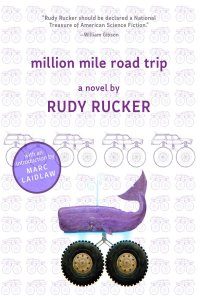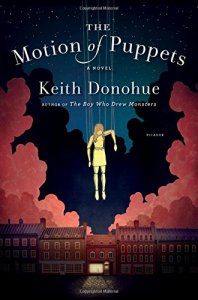Gary K. Wolfe Reviews Million Mile Road Trip by Rudy Rucker
 Million Mile Road Trip, Rudy Rucker (Night Shade 978-1-94094838-6, $24.99, 504pp, hc) May 2019.
Million Mile Road Trip, Rudy Rucker (Night Shade 978-1-94094838-6, $24.99, 504pp, hc) May 2019.
There’s little doubt that Rudy Rucker deserves his reputation as one of the founders of cyberpunk – his Software predated Neuromancer by a couple of years – but his own literary origins seem to reach as far back as Lewis Carroll and Edwin A. Abbott, to whose Flatland Rucker paid a kind of parodic tribute with his own Spaceland back in 2002. Both influences are apparent in Rucker’s latest delirious epic, Million Mile Road Trip, which also mixes in elements of Kerouac, surfer-dude culture, the high school outsider novel, Road Runner cartoons, flying saucer lore, teen romance, and even a touch of Miles Davis. Mostly, though, it’s characteristic Rucker, with a torrent of clever inventions and sidebar adventures that constantly threaten to overwhelm the central plot, and colorful nomenclature that sometimes suggests more whimsy than is actually the case. Fairly early on, we’re told, “the ceaseless flow of strange people and alien creatures is getting to Villy” (one of the teenage heroes charged with saving the world), and by the time we’ve acquainted ourselves with Rucker’s various Szeps, Thudds, Freeths, Flatsies, Bubblers, Harmons, fractal ants, leech saucers, and Tollah dogs, we’re more than ready to agree with him.
Fortunately, for all the gonzo free-range improvisation, the plot itself is rather straightforward, and familiar. Zoe Snapp and her best friend Villy Antwerpen are seniors at Los Perros High School (Rucker’s alternate name for his own town of Los Gatos), and inevitably, both are quirky outsiders. Zoe is mostly interested in practicing jazz trumpet, while Villy “has zero ambition and low self-esteem,” although he’s a skilled surfer and has enough mechanical skills to maintain his aging station wagon, which he calls the purple whale. That turns out to be the vehicle of choice for the titular road trip, which gets underway after Zoe and Villy are visited by aliens named Yampa and Pinchley, who recruit them on a mission to “mappyworld” – an apparently endless flat continent in which the different worlds (what we would call planets in our own “ballyworld”) are simply a series of basins separated by mountain ranges. Ever the mathematical fantasist, Rucker works out the topology of mapping out the various dimensions, including a fourth dimension that comes into play with the “unny tunnels” – essentially wormholes – that connect our world and mappyworld.
The reason the teens are needed is to help prevent the invasion of Earth by a supervillain named Groon, a sort of giant, ill-tempered bagpipe who commands a force of living flying saucers. Accompanied by their two alien visitors and Villy’s annoying younger brother Scud, they set out in the purple whale, which soon gets an alien tech makeover (including giant monster truck tires) which enables it to travel thousands of miles an hour over all sorts of terrain; the million miles isn’t just a figure of speech because, once again, Rucker has bothered to work out the math. Along the way, they meet various helpers and antagonists, encounter the jabberwocky-like alien races mentioned above, and visit various basin-worlds such as the Earthlike Van Cott, Szep City, New Eden, and Surf World (where intelligent waves go in whatever direction they feel like, making it a life challenge for Villy). Those various alien critters and societies are either the core of the novel or rambling distractions from the plot (which does get resolved in a not-too-surprising way), but then plot isn’t really what you should be reading for in a Rucker novel, or for that matter in any sort of road novel (try to describe a plot in On the Road). What you read for is the storm of inventions, some silly and some provocative, and the underlying pattern of weird logical gamesmanship that makes patterns out of puzzles and puzzles out of patterns, and which reminds us that this might be exactly the sort of thing Lewis Carroll would be up to if he’d known about Einstein-Rosen bridges and modern geek teen culture.
Gary K. Wolfe is Emeritus Professor of Humanities at Roosevelt University and a reviewer for Locus magazine since 1991. His reviews have been collected in Soundings (BSFA Award 2006; Hugo nominee), Bearings (Hugo nominee 2011), and Sightings (2011), and his Evaporating Genres: Essays on Fantastic Literature (Wesleyan) received the Locus Award in 2012. Earlier books include The Known and the Unknown: The Iconography of Science Fiction (Eaton Award, 1981), Harlan Ellison: The Edge of Forever (with Ellen Weil, 2002), and David Lindsay (1982). For the Library of America, he edited American Science Fiction: Nine Classic Novels of the 1950s in 2012, with a similar set for the 1960s forthcoming. He has received the Pilgrim Award from the Science Fiction Research Association, the Distinguished Scholarship Award from the International Association for the Fantastic in the Arts, and a Special World Fantasy Award for criticism. His 24-lecture series How Great Science Fiction Works appeared from The Great Courses in 2016. He has received six Hugo nominations, two for his reviews collections and four for The Coode Street Podcast, which he has co-hosted with Jonathan Strahan for more than 300 episodes. He lives in Chicago.
This review and more like it in the July 2019 issue of Locus.
 While you are here, please take a moment to support Locus with a one-time or recurring donation. We rely on reader donations to keep the magazine and site going, and would like to keep the site paywall free, but WE NEED YOUR FINANCIAL SUPPORT to continue quality coverage of the science fiction and fantasy field.
While you are here, please take a moment to support Locus with a one-time or recurring donation. We rely on reader donations to keep the magazine and site going, and would like to keep the site paywall free, but WE NEED YOUR FINANCIAL SUPPORT to continue quality coverage of the science fiction and fantasy field.







